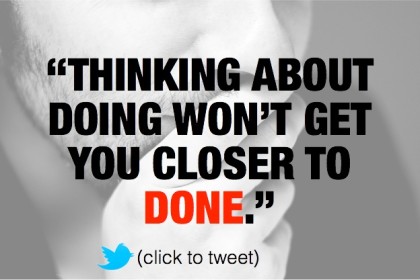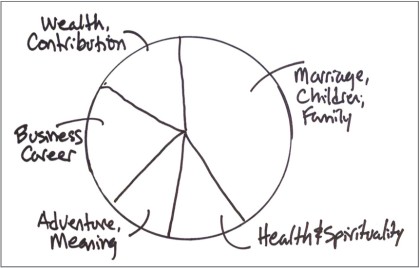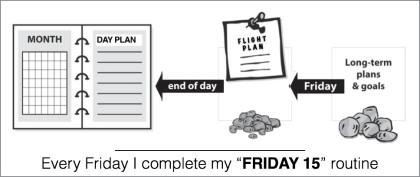How to (finally) get your To Do list out of your head, organized, and done.
I was speaking with a client today about their conference. In a couple of months I’ll be on their main stage and I was pressuring him to learn about the outcomes he wanted.
“Every day I have 17 projects that need my attention.” he said “If you can just help me get them out of my head, that would be great.”
He’s not alone.
Of the almost 500 people who completed my client survey this Spring, two of the most common barriers to success were overwhelm and chronic stress (watch for a future post about those survey results). Sound familiar?
I have a surprisingly simple solution. It's a system I teach people in all my time management seminars and folks love it. I call it Plan Like A Pilot and it can remove any grief you might be experiencing from lists, overwhelm, and impending deadlines … I’ll get to that in just a minute. First, let’s get one thing straight.
Thinking about doing won’t get you closer to done.
THINKING ABOUT DOING WON’T GET YOU CLOSER TO DONE.
There is a time to think, plan, and act to get a project rolling downhill to completion. The rest of the time, your projects need to be parked in a home with the door closed and you need to stop thinking about them.
with the door closed and you need to stop thinking about them.
Worrying, fretting, strategizing, and NOT DOING burns you out and creates a negative feedback loop. Harvard Prof. and best-selling author Daniel Gilbert talks about our "psychological immune system" that is strengthened, or weakened, because of what we ruminate on. Think optimistically and you are healthier and more likely to forge forward overcoming resistance. Focus on what's not working and you are more likely to balk at any sign of resistance.
Here’s my test for you. Answer these three questions and it should be pretty clear if you need help.
- Do you frequently worry you will forget to do something at work or a home?
- Have some papers, notes, files, stickies, or reminders been on your desk longer than a week?
- Do you have more than one list for keeping track of your plans and tasks?
If you answered “Yes” to any one these - read on because you are going to love what I’m about to share (if you answered “Yes” to all of these - stay after class.)
Eeyore, tells Pooh, “We can’t all, and some of us don’t. That’s all there is to it.” - A. A. Milne’s
Now, onto the best damn system for parking your To Do’s (if I say so myself).
THE BEST DAMN SYSTEM FOR PARKING YOUR TO DO’S
A good planning system has three features:
- everything is organized in one place,
- easy access,
- minimal time for upkeep.
That’s why I invented my Plan Like A Pilot (PLAP) planning system - it gives a home to all your plans and wishes, it’s all in one place, and it’s easy to maintain. Learn more about the PLAP system in my book Give Me a Break.
In this post I’m going to share the format I use for recording everything I am working on. It starts with recognizing all the types of data you have - there are (at least) five.
A PLACE FOR EVERYTHING AND EVERYTHING IN IT’S PLACE
The Plan Like A Pilot (PLAP) Map gives you five places to park whatever is keeping your neurons flapping their little dendrites. Here they are:
1. LIFE PLAN - this is the scary stuff - life aspirations. About twice a year I crack open this thick novel, peel back the pages, and peer down the paths my life is following. There are five of them (you might have more, but I've only got five fingers on my hand):
paths my life is following. There are five of them (you might have more, but I've only got five fingers on my hand):
- marriage, children, family
- health and spirituality
- adventure and meaning
- business and career
- wealth and contribution
2. YEAR PLAN - these are the “Boulders” - the big stuff I want to happen that often rolls off the path and get stalled. I want them front and centre and challenging me. That list includes:
- Net wealth from business and investments (see "Why $100,000 a year won't make you rich")
- Family and personal adventures (camping, travel, competitions, retreats)
- Personal challenge: hours I’m willing to work, habits I’m practicing, skills I'm learning (like singing)
- Business: Sales and net income, client metrics (web site traffic, client list, keynotes, etc.), products and promotions, staffing, etc.
3. FLIGHT PLAN - this is a short list of what has to happen by Friday (watch my video about creating your Flight Plan, below). I like to keep this list to 12, or fewer items.
4. THIS MONTH - unsorted list of work for the current month. These are ignored until each Friday, when I review them and decide if they move to the Flight Plan (see my post "Friday 15 - my little secret to setting up a super week").
5. SOMEDAY - ideas, random suggestions from colleagues, “great” ideas I hear on podcasts, and left-overs from previous months stay here. As with “This Month”, these are ignored until the Friday 15 review (see below).
Just like a pilot’s flight plan, once I have the big picture dialled in, I need to look at what happens immediately. A pilot has loading instructions and check lists, I have a Day Plan. The Day Plan is what I commit to today. And it's driven by the Flight Plan. Download a copy of my PLAP planner.
Here’s how it works.
ENTER THE DAY PLAN
Every Friday I complete my “FRIDAY 15” routine - 15 minutes where I:
REVIEW the week - what worked, what didn’t, what discipline was lacking, what habits need a kick in the routine.
RETHINK my PLAP map - what needs to be upgraded from “This Month”, or “Someday” to the Flight Plan, what needs to be down-graded. What can I delegate? What can I do right now, or dump, or defer? My goal is for the Flight Plan to be realistic and accurate - I want to feel positive when I read it, not overwhelmed.
REVISE my Flight Plan and create a new Day Plan.

I use a note pad for my Day Plan. By the end of the day it’s covered in scribbles and (hopefully) lots of tasks crossed off.
THE FINAL PIECE TO THE PLAP SYSTEM
Once I have my PLAP map and my Day Plan, I update both at the end of every day (Monday - Thursday). The full review, rethink, revise cycle happens on Friday.
So, there you have it: a PLAP Map and a Day Plan. That’s my life, recorded in 1,500 words, or less (rather sad isn’t it?).
And now a word about discipline.
HOW TO KEEP YOUR HANDS OUT OF THE TO DO JAR
A system is only as good as the operator (that’s you, dear reader). The Plan Like a Pilot system only works if you put your attention on the Flight Plan and keep your hands out of the TO DO jar.
In other words, follow a habit of putting every idea, task, “I wonder if…”, and “To Do” in one of the five rooms in your PLAP Map. No sickies, no multiple-synced-color-coded-I’m-so-clever calendars, leather-bound journals, or cool apps. Your goal should be to put everything in one place and become a master at effectively working on one thing at a time (now, there’s a concept!).
** Will this help? Tell me in the comments - I want to know! **
Small Wins - Why Little Steps are the Path to Big Rewards
Keynotes and workshops by Hugh Culver


